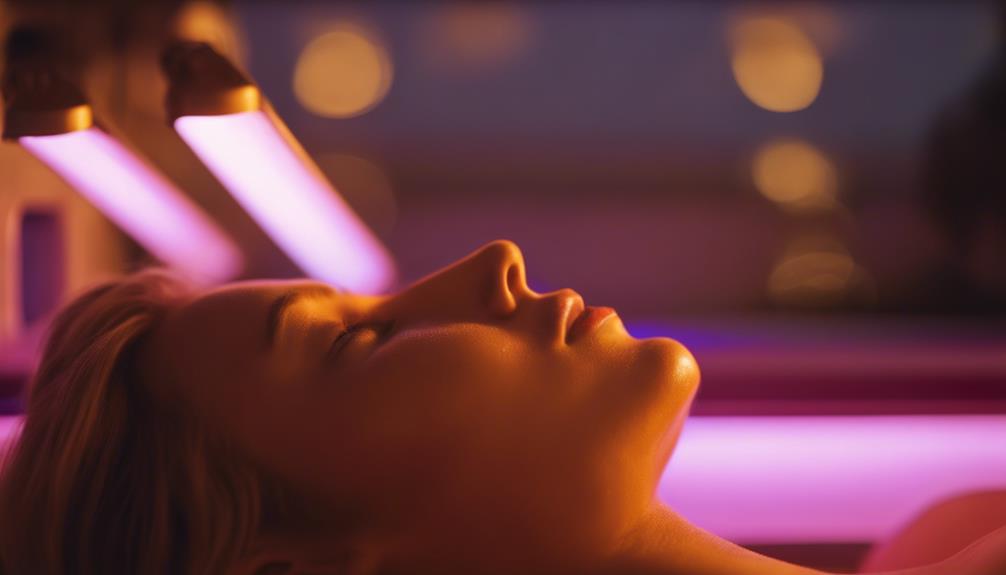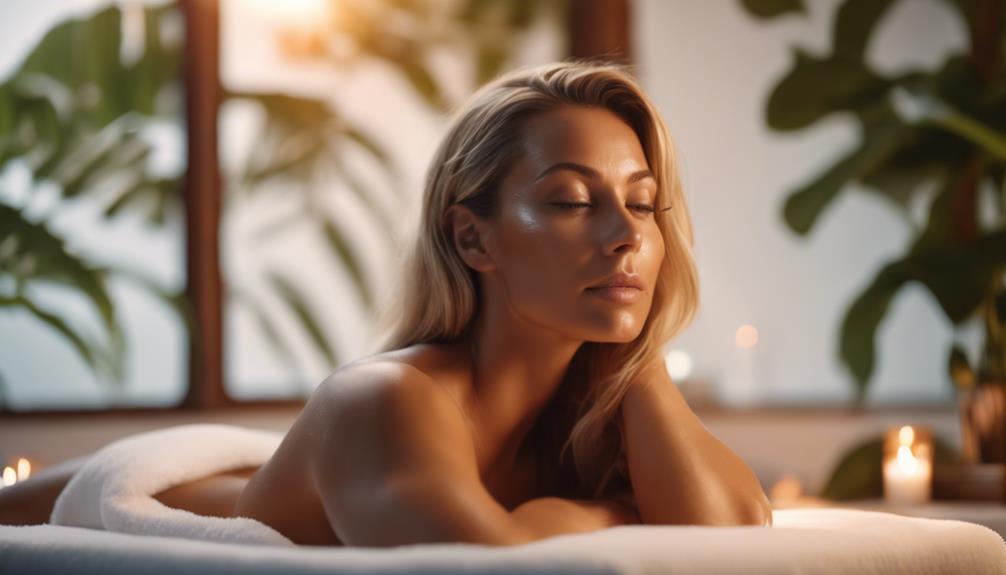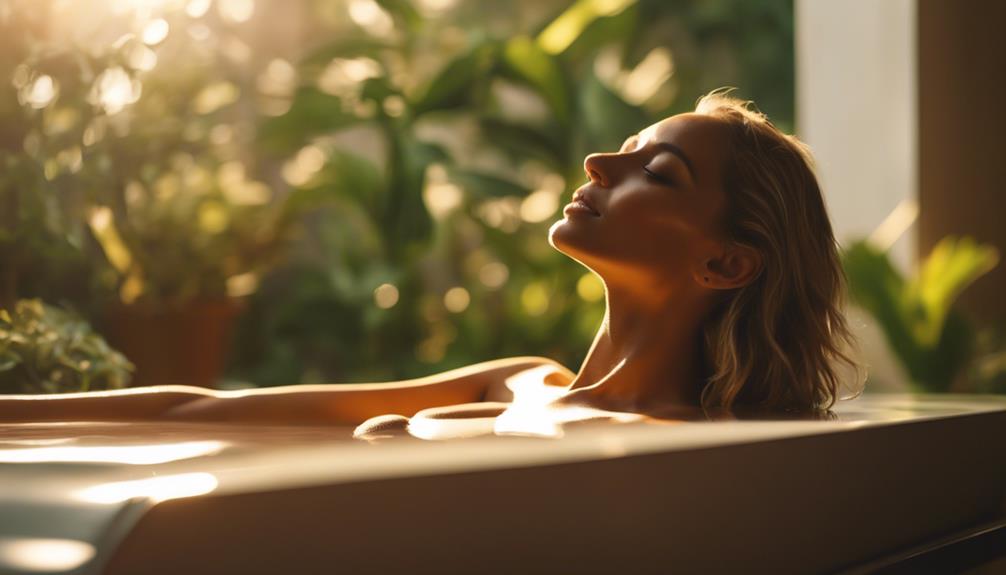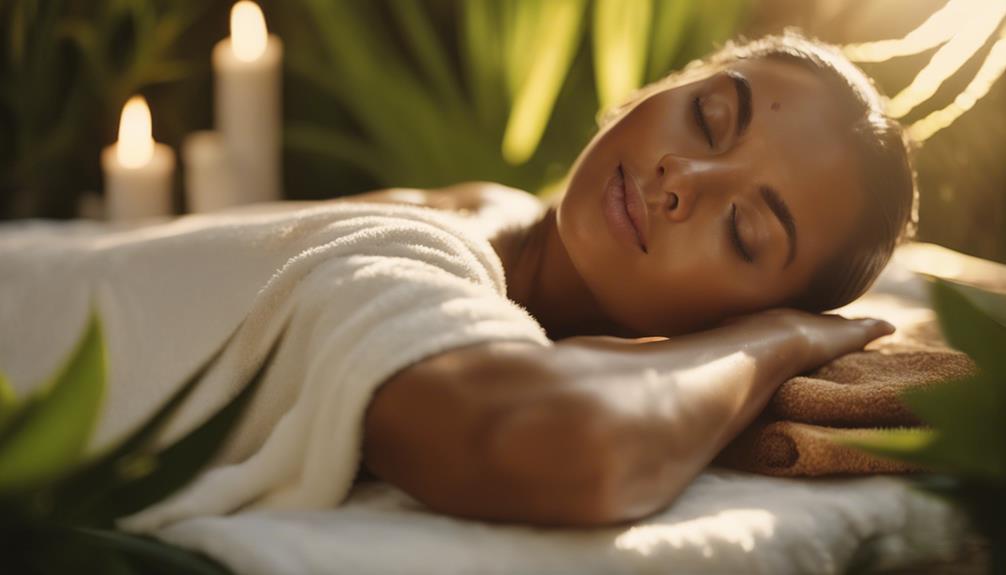Tanning beds can be a helpful way for you to access vitamin D, especially when sunlight is scarce. These beds primarily emit UVB rays, which are essential for stimulating vitamin D production in your body. By limiting your sessions to 5-10 minutes, you can enjoy the benefits while minimizing risks. Using protective eyewear and moisturizing afterward are smart practices to enhance your experience and promote skin health. Understanding how these beds work allows you to tailor your sessions to your skin type. If you're curious about maximizing these benefits, there's more to discover about safe tanning practices and alternatives.
Key Takeaways
- Tanning beds use UVB rays to enhance vitamin D production, crucial for immune function and overall health.
- Controlled exposure in tanning beds can provide vitamin D benefits during months with limited sunlight.
- Ideal sessions last 5-10 minutes, balancing effective vitamin D intake while minimizing skin damage risks.
- Moisturizing post-tanning helps maintain skin health and combat dryness after UV exposure.
Tanning Beds and Vitamin D
Tanning beds offer a controlled way for you to boost your vitamin D levels, especially during the darker months when sunlight is scarce. By using UVB rays, these beds stimulate your skin's vitamin D production, which is essential for your immune system and overall health.
You can personalize your tanning sessions, adjusting the exposure time to maximize vitamin D synthesis. This indoor tanning experience mimics natural sunlight, making it a practical alternative when you're unable to bask outdoors.
Moderate UVB exposure may also reduce the risk of chronic diseases and certain cancers. Plus, vitamin D plays a role in elevating your mood, making tanning beds beneficial for your mental well-being during those gloomy winter days.
Safe Tanning Practices
To enjoy the benefits of tanning beds while minimizing risks, it's important to follow safe tanning practices. Limit your sessions to 5-10 minutes and always wear protective eyewear to shield your eyes. Familiarize yourself with the difference between UVA and UVB rays to select appropriate products. Remember, overexposure can lead to skin damage and increase your risk of skin cancer, especially if you're under 30. Here's a quick reference table to help you stay informed:
| Safe Tanning Practice | Description |
|---|---|
| Limit Session Duration | Keep sessions under 10 minutes |
| Wear Protective Eyewear | Protect your eyes from UV rays |
| Understand UV Rays | Know the difference between UVA and UVB |
| Moisturize After Tanning | Combat skin dryness post-session |
| Regular Skin Checks | Monitor for changes in your skin |
Understanding Tanning Bed Mechanisms

Understanding how tanning beds work is key to maximizing vitamin D production while minimizing risks. Tanning beds emit both UVA and UVB rays, but it's the UVB rays that specifically stimulate your skin to produce vitamin D.
This controlled exposure mimics the sun's rays, allowing you to gain the benefits of vitamin D even when natural sunlight is scarce. You can personalize your tanning sessions to achieve ideal results based on your skin type and needs.
It's crucial to be aware of the mechanisms at play, as this knowledge empowers you to make informed decisions about tanning. By understanding these mechanisms, you can enjoy the benefits of tanning beds while being mindful of safety precautions.
Optimal Session Duration
Maximizing the benefits of tanning beds involves knowing the ideal session duration for effective vitamin D intake. Generally, you should aim for sessions lasting between 5 to 10 minutes. This timeframe strikes a balance, allowing your skin to absorb sufficient UVB rays without risking overexposure.
Consistency is key; regular sessions will enhance your vitamin D production and maintain healthy levels. Avoid lengthy sessions, as they can lead to skin damage and increase the risk of skin cancer.
Always listen to your body and adjust your tanning routine based on your skin type and sensitivity. By adhering to these guidelines, you can enjoy the advantages of tanning beds while minimizing potential risks.
Skin Care After Tanning

Proper skin care after tanning is essential to maintain hydration and prevent dryness caused by UV exposure. Your skin needs extra attention to recover and stay healthy.
Here are three key steps you should follow:
- Moisturize: Apply a rich moisturizer immediately after your tanning session. This helps lock in moisture and replenish your skin's hydration.
- Gentle Cleanse: Use a mild, hydrating cleanser to wash off any tanning products or sweat. Avoid harsh soaps that can strip your skin of essential oils.
- Hydrate: Drink plenty of water to support your skin from the inside out. Staying hydrated helps maintain elasticity and reduces the risk of dryness.
Alternative Vitamin D Sources
There are several alternative sources of vitamin D that can help you maintain adequate levels without relying solely on tanning beds or sun exposure. You can incorporate these options into your routine:
| Source | Vitamin D Content |
|---|---|
| Fatty Fish (Salmon) | 570 IU per 3.5 oz |
| Fortified Milk | 100 IU per cup |
| Egg Yolks | 37 IU per yolk |
| Mushrooms (UV-exposed) | 450 IU per cup |
| Supplements (Vitamin D3) | Varies by dosage |
Addressing Common Concerns

Addressing concerns about vitamin D and tanning beds involves understanding both the benefits and risks associated with their use.
While tanning beds can help maintain your vitamin D levels, it's essential to recognize their potential downsides.
Here are three key points to take into account:
- Moderation is Key: Limit your sessions to prevent overexposure and reduce the risk of skin damage.
- Protect Your Skin: Always use protective eyewear and follow guidelines to safeguard your skin health.
- Know Your Skin Type: Different skin types react differently to UV exposure, so tailor your sessions accordingly.
Frequently Asked Questions
How Do Tanning Beds Compare to Natural Sunlight for Vitamin D Production?
Tanning beds provide a controlled environment for vitamin D production, similar to natural sunlight. However, you should be cautious of overexposure risks and always prioritize skin protection to minimize potential harm while seeking vitamin D benefits.
Can Tanning Beds Help With Seasonal Affective Disorder (Sad)?
Tanning beds can act like a sunlit oasis during winter's gloom, helping you combat Seasonal Affective Disorder. They may boost your mood by mimicking sunlight, but remember to use them safely and in moderation.
Are There Specific Skin Types That Benefit More From Tanning Beds?
Yes, certain skin types, particularly those with lighter skin, might benefit more from tanning beds due to their increased sensitivity to UV exposure. However, always prioritize safety and moderation to minimize risks associated with tanning.
How Often Should I Use a Tanning Bed for Optimal Vitamin D Levels?
To optimize vitamin D levels, you should use a tanning bed about 1-2 times a week, keeping sessions between 5-10 minutes. Always prioritize safety and adhere to guidelines to minimize skin damage risks.
What Should I Consider Before Starting Tanning Bed Sessions?
Before starting tanning bed sessions, consider your skin type, session length, and potential risks. Isn't your health worth careful thought? Also, prioritize protective eyewear and follow guidelines to minimize skin damage while maximizing benefits.
Conclusion
Incorporating tanning beds into your routine can be like finding sunlight in a snowstorm—both warm and uplifting. Just remember, moderation is key.
By following safe tanning practices and caring for your skin, you can enjoy the benefits of vitamin D while minimizing risks. Think of this approach as your personal winter sun, brightening your mood and health.
So, embrace the glow and keep your vitamin D levels in check, even when the days are short and the skies are gray.









